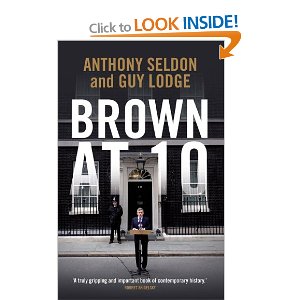Brown at 10: the authoritative account – which lays into Ed Balls
 When it first came out Brown at 10 by Anthony Seldon and Guy Lodge was extremely well received for its authoritative detail and the revised paperback edition maintains that standard well.
When it first came out Brown at 10 by Anthony Seldon and Guy Lodge was extremely well received for its authoritative detail and the revised paperback edition maintains that standard well.
With Seldon being one of the founders of the modern school of contemporary history, it is no surprise that the book follows the thorough, heavily documented approach contemporary historians strive for – with over 1 million words of interviews recorded for posterity (even if many are, for the next 30 years, withheld from public view) and extensive access to private diaries.
The huge depth of research is accompanied by a fairly narrow focus – this is politics as seen through the eyes of Whitehall insiders, both in the civil service and in the Labour Party. That strength is only occasionally a weakness – most notably in the account of the May 2010 hung Parliament negotiations, which is remarkably favourable to a small number of Labour figures and glosses over Labour’s failure to prepare for a hung Parliament despite for many months that being widely seen internally as not only the party’s best but also only hope.
Indeed, this account is bookended by two unanswered questions: why are we now drowning in Labour figures who are revealed as having been critics of Gordon Brown all along yet did not back a contested leadership election, and why was Labour so unprepared for hung Parliament talks that the preparations of its negotiation team added up to little more than a quick cup of tea between Ed Balls and Peter Mandelson before walking into the negotiating room? Those two big acts of omission frame Brown’s rise and fall and are largely absent from the book, though it does provide hints of partial answers.
Their absence from the book is deliberate for neither question features in the list of ten questions provided at the start of the book as forming its structure and purpose. In filling the gap between these two questions with their own ten questions, the authors do an excellent job, telling the story of a Gordon Brown who, having been consumed with plotting and addicted to spending money to win internal Labour support from 2003, was a dreadful Prime Minister until the financial crisis forced the best out of him. “Brown will go down in history as the creator and destroyer of New Labour, and then, at the last minute, its guilty and ineffective reviver,” they conclude.
Despite those stringent criticism of Brown, in many ways the person who comes out of the book worst is Ed Balls – the uber plotter even pursing plots in secret from Brown when he feared Brown would not have the bottle for them, “the most unpleasant bully I have come across” in the words a colleague and the liar denying in public what he did in private.
Coming a close second to Balls are Harriet Harman (also fingered as a plotter against Brown, trying to marshal Cabinet members into ousting him) and British political journalists, a handful of whom are frequently pictured as being the far too uncritical recipients of misleading leaks and personal smears, published under their bylines and reduced to being mouthpieces for Labour infighting rather than independent seekers of truth.
The book’s narrative structure shows just how much of a Prime Minister’s time is taken up with security and foreign affairs matters – a pattern which David Cameron has been reported as being surprised by too after he took office.
With a number of other detailed accounts also published, there is little that is strikingly new in Brown at 10, though some details are wonderfully evocative – as when an aide hustled Gordon Brown into a building and behind a curtain so that he would avoid having to meet Robert Mugabe outside the UN or the story of how Ed Miliband helped craft the “this is no time for a novice” put down aimed at his brother David. News such as Gordon Brown breaking a mobile phone by throwing it away in anger is, however, no longer news even if it is reassuring to know that detailed research backs up such stories.
For a one volume account of the Brown years as Prime Minister, this book is hard to beat. If, however, you have already been a voracious consumer of memoirs and political news and have a good memory, there will be little new to be found in it.
You can buy Brown at 10 by Anthony Seldon and Guy Lodge here.
@markpack reviews BROWN AT 10 by Anthony Seldon and Guy Lodge http://t.co/5r8Fhwah
Brown, "creator and destroyer of New Labour, & then, at the last min, its guilty & ineffective reviver” Seldon & Lodge http://t.co/gaThQZKK
History will record Brown as the man who never understood capitalism, socialised the bankers debts & lost a generation http://t.co/QAHP2ZML